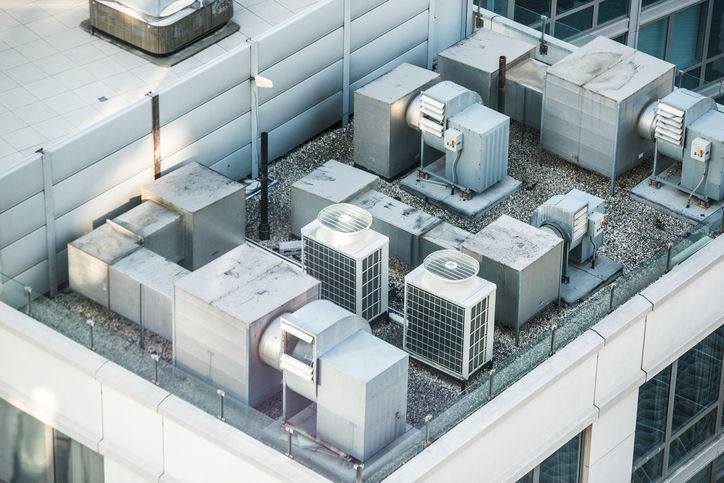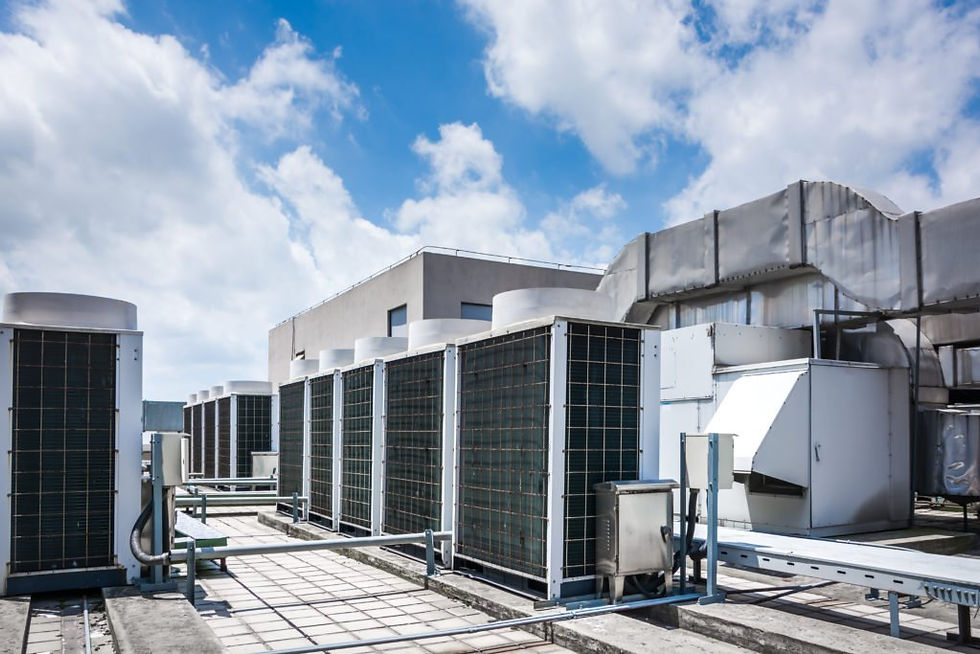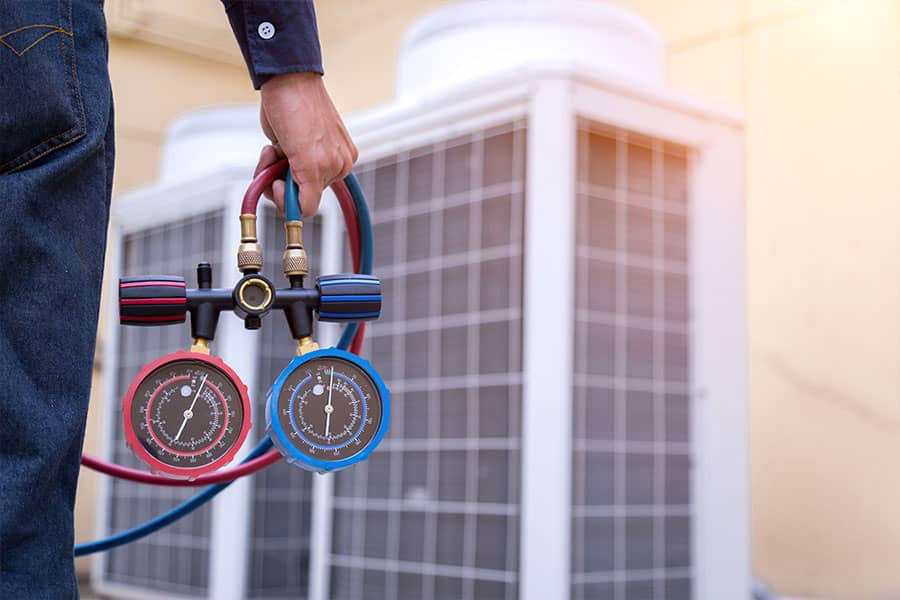
.png)
Comprehensive Commercial HVAC Guide

Understanding the Unique Demands of Commercial HVAC
Commercial HVAC systems are critical for maintaining comfortable, safe, and efficient indoor environments across various business sectors. Unlike residential systems, commercial HVAC solutions must address larger spaces, diverse occupancy patterns, and specific operational needs, making them a complex but vital investment for businesses. From small retail shops to sprawling industrial facilities, the demands on commercial HVAC systems vary significantly, requiring tailored solutions to ensure energy efficiency, compliance with regulations, and optimal performance.
For small businesses, such as local restaurants or retail stores, HVAC systems must balance cost-effectiveness with reliable climate control to enhance customer experience while keeping operational expenses manageable. Manufacturing facilities require robust systems capable of handling high heat loads from machinery, maintaining precise temperature and humidity levels to protect equipment and ensure worker safety. Industrial refrigeration, critical for sectors like food processing and pharmaceuticals, demands specialized systems to maintain strict temperature controls for perishable goods or sensitive materials. These diverse needs underscore the importance of customized HVAC solutions that align with each business’s unique operational goals.
JR Hobbs Market Segments & Commercial HVAC Requirements
Hospitality
The hospitality sector, including hotels and resorts, relies heavily on HVAC systems to ensure guest comfort and satisfaction. These facilities operate 24/7, requiring consistent climate control across diverse spaces like guest rooms, lobbies, and event venues. Energy-efficient systems, such as Variable Refrigerant Flow (VRF) systems, are increasingly popular for their ability to provide zoned climate control, reducing energy waste in unoccupied areas. Additionally, the hospitality industry prioritizes indoor air quality (IAQ) to meet health standards and enhance guest experiences, particularly post-COVID, with advanced filtration and ventilation systems becoming standard.
Food & Beverage
In the food and beverage sector, HVAC and refrigeration systems are mission-critical for food safety and quality. Restaurants, supermarkets, and food processing facilities require precise temperature and humidity control to preserve perishable items and comply with stringent health regulations. Commercial refrigeration equipment, such as blast chillers and beverage coolers, supports rapid cooling and safe storage, while ventilation systems mitigate heat and odors from cooking processes. The sector is seeing a shift toward eco-friendly refrigerants and IoT-enabled systems for real-time monitoring to prevent spoilage and reduce energy costs.
Office
Office buildings demand HVAC systems that maintain consistent temperatures and air quality to enhance employee productivity and comfort. Systems must accommodate fluctuating occupancy levels, particularly in open-plan or multi-zone offices. VRF systems and smart thermostats are increasingly adopted to optimize energy use, while post-COVID ventilation upgrades, such as those aligned with ASHRAE Standard 241, ensure healthier indoor environments. Energy efficiency is a priority, driven by green building certifications like LEED and rising energy costs.
Retail
Retail environments, from small boutiques to large shopping malls, require HVAC systems that create inviting atmospheres for customers while managing high foot traffic. Ductless mini-splits and zoned systems are ideal for smaller stores, while larger retail spaces rely on centralized systems with advanced controls. Energy-efficient solutions help retailers reduce operational costs, and IAQ improvements, including enhanced filtration, address consumer health concerns, particularly in high-traffic areas.
Manufacturing
Manufacturing facilities face unique HVAC challenges due to high heat loads from machinery, dust, and chemical byproducts. Systems must provide robust ventilation and precise climate control to protect equipment, ensure product quality, and maintain worker safety. Industrial HVAC systems often integrate with building automation systems (BAS) to monitor and adjust conditions in real time. Energy-efficient solutions, such as heat recovery systems, are critical to managing costs in energy-intensive environments.
Multi-Tenant
Multi-tenant buildings, such as office complexes or apartment buildings, require flexible HVAC systems to accommodate diverse tenant needs. VRF systems are popular for their ability to provide individualized climate control for different zones, ensuring tenant comfort while optimizing energy use. These systems must also comply with strict building codes and sustainability standards, with regular maintenance essential to prevent disruptions across multiple tenants.
Government
Government facilities, including offices, courthouses, and public institutions, prioritize energy efficiency and compliance with federal and state regulations, such as those under the Federal Energy Management Program (FEMP). HVAC systems must support large, high-occupancy spaces while meeting strict IAQ and sustainability standards. Retrofitting older buildings with modern, energy-efficient systems is a growing trend, supported by federal incentives like those under the Inflation Reduction Act.
Healthcare
Healthcare facilities, such as hospitals and clinics, require HVAC systems that ensure sterile environments, precise temperature control, and superior air quality to prevent infection spread. Systems must operate 24/7, with redundancy to avoid downtime, which could pose life-safety risks. Advanced filtration, humidity control, and compliance with ASHRAE standards are non-negotiable, and the sector is increasingly adopting IoT-enabled systems for predictive maintenance to ensure reliability.

Energy Efficiency and Sustainability
Stricter regulations, such as the U.S. AIM Act and the EU’s F-Gas Regulation, are phasing out high-GWP refrigerants like R-410A in favor of low-GWP alternatives like R-32 and R-454B. Businesses are adopting energy-efficient technologies, such as VRF systems, heat pumps, and smart controls, to reduce operational costs and meet sustainability goals.
Smart Technology Integration
The integration of IoT, AI, and building automation systems is transforming HVAC management. Smart thermostats, remote diagnostics, and predictive maintenance tools reduce downtime and energy consumption by up to 20%, improving system efficiency and longevity.
Several Trends Are Shaping the Commercial HVAC Market

Focus on Indoor Air Quality
Global decarbonization efforts, supported by policies like the U.S. Inflation Reduction Act and China’s Dual Carbon Policy, are driving the adoption of electric heat pumps and renewable energy-integrated systems. These technologies reduce carbon footprints while offering long-term cost savings
Decarbonization and Electrification
Post-COVID, regulations like ASHRAE Standard 241 emphasize enhanced ventilation and filtration to improve IAQ. This is particularly critical in healthcare, hospitality, and office settings, where occupant health is a priority.

HVAC Regulatory Landscape
The commercial HVAC industry is heavily influenced by regulations aimed at improving energy efficiency and reducing environmental impact. Key regulations include:
U.S. AIM Act (2025): Mandates an 85% reduction in hydrofluorocarbon (HFC) production by 2036, with R-410A phased out for new equipment starting January 2025. This requires businesses to invest in A2L refrigerants and upgrade tools and training.
ASHRAE Standards: Standards like ASHRAE 90.1 (energy efficiency) and 241 (air quality) set benchmarks for HVAC performance in commercial buildings, influencing system design and operation.
Inflation Reduction Act (U.S.): Provides federal rebates and tax credits for energy-efficient HVAC upgrades, encouraging businesses to adopt heat pumps and smart controls.
EU F-Gas Regulation: Targets a 70% reduction in HFC emissions by 2030, driving the adoption of low-GWP refrigerants like R-32 in commercial chillers.
India’s Energy Conservation Building Code (ECBC): Mandates VRF systems and heat pumps in new commercial buildings, supporting India’s growing HVAC market

Capital Deferment Strategies
Deferring capital expenditures on HVAC systems can help businesses manage cash flow while maintaining operational efficiency. Capital deferment involves extending the life of existing systems through targeted maintenance and upgrades rather than immediate replacement. Strategies include:
Proactive Repairs: Addressing minor issues, such as worn bearings or inefficient motors, can delay the need for full system replacements, preserving capital for other business priorities.
Component Upgrades: Retrofitting specific components, like variable-speed drives or advanced controls, can improve efficiency and extend system life without the cost of a new system.
Lease-to-Own Models: Leasing HVAC equipment allows businesses to spread costs over time, aligning with short-term cash flow constraints while planning for eventual ownership
These strategies must be balanced with long-term financial goals, such as reducing energy expenses and meeting sustainability targets, to avoid excessive maintenance costs that could outweigh replacement benefits.

Preventive Maintenance Contracts
Preventive maintenance is essential for extending HVAC system lifespan and avoiding costly repairs. Maintenance contracts offer predictable cost management and uptime protection. Key practices include:
Regular inspections and cleaning of filters, coils, and ducts to maintain efficiency.
IoT-enabled monitoring to predict and address issues before they cause system failures
Compliance audits to ensure adherence to refrigerant and energy efficiency regulations.
JR Hobbs offers tailored maintenance contracts that align with each market segment’s operational and financial goals, ensuring optimal performance and regulatory compliance while supporting budget predictability.

Retrofitting and Upgrades
With aging infrastructure and evolving regulations, retrofitting is a cost-effective alternative to full system replacements. Upgrading older systems with energy-efficient components, such as variable-speed compressors or low-GWP refrigerants, extends system life and reduces energy costs. Federal and state incentives, like those under the Inflation Reduction Act, offset retrofit costs, making them an attractive option for businesses aiming to balance short-term budgets with long-term savings.
Retrofitting and Upgrades
With aging infrastructure and evolving regulations, retrofitting is a cost-effective alternative to full system replacements. Upgrading older systems with energy-efficient components, such as variable-speed compressors or low-GWP refrigerants, extends system life and reduces energy costs. Federal and state incentives, like those under the Inflation Reduction Act, offset retrofit costs, making them an attractive option for businesses aiming to balance short-term budgets with long-term savings.

Financing and Investment Planning
The high upfront cost of commercial HVAC units—ranging from USD 15,000 to USD 40,000 for replacements—requires strategic financial planning to align with both immediate and future financial objectives. Businesses can:
Leverage Incentives: Utilize federal and state rebates, such as those under the Inflation Reduction Act, to reduce initial costs and accelerate ROI.
Explore Leasing Models: Refrigeration-as-a-Service and similar subscription models allow businesses to access advanced systems without significant upfront investment, preserving capital for short-term needs like expansion or inventory.
Partner with Financial Institutions: Financing options from banks or private equity can fund large-scale HVAC projects, enabling businesses to adopt cutting-edge technologies while spreading costs over time to align with long-term revenue goals.
By aligning financing strategies with short-term cash flow needs and long-term profitability targets, businesses can invest in HVAC systems that support growth without compromising financial stability.

Sustainability and Long-Term ROI
Investing in sustainable HVAC solutions aligns with global decarbonization goals and delivers long-term cost savings, critical for achieving financial objectives. For example, heat pumps are 3-4 times more efficient than gas boilers, significantly reducing energy costs. Businesses should prioritize systems that support green certifications like LEED or ENERGY STAR to enhance property value, attract eco-conscious tenants or customers, and align with long-term sustainability goals. These investments reduce operational expenses over time, supporting financial stability and competitiveness.
By strategically managing HVAC investments through capital deferment, preventive maintenance, retrofitting, financing, workforce development, and sustainability, businesses can achieve both short-term financial flexibility and long-term ROI. JR Hobbs partners with clients to align HVAC strategies with their financial goals, ensuring cost-effective, compliant, and sustainable solutions.

JR Hobbs’ Approach to Commercial HVAC
As a leading provider in the Southeastern U.S., JR Hobbs combines expertise, innovation, and customer-centric solutions to address the unique needs of each market segment. From designing energy-efficient systems for hospitality clients to maintaining industrial refrigeration for manufacturing facilities, JR Hobbs ensures compliance, reliability, and cost-effectiveness. Our services include:
Custom System Design: Tailored HVAC solutions for small businesses, multi-tenant buildings, and industrial applications
Implementation and Project Management: Whether installing a single unit or managing a large manufacturing upgrade, JR Hobbs provides program management that is transparent and delivers high quality according to the agreed schedule.
Preventive Maintenance: Comprehensive contracts to maximize system lifespan and efficiency.
Retrofit and Upgrade Services: Cost-effective solutions to modernize aging systems and ensure regulatory compliance.
24/7 Support: Rapid response times to minimize downtime, particularly for critical sectors like healthcare and food and beverage.
The commercial HVAC market is poised for significant growth, companies need an HVAC partner that can provide reliable service, regulatory mandates, bring the right technological advancements to each opportunity, and meet the increasing demand for sustainable solutions. Businesses across hospitality, food and beverage, office, retail, manufacturing, multi-tenant, government, and healthcare sectors must view HVAC systems as strategic capital investments. By prioritizing energy efficiency, preventive maintenance, and compliance with evolving regulations, businesses can enhance operational efficiency, reduce costs, and meet sustainability goals. JR Hobbs stands ready to partner with businesses to deliver customized HVAC solutions that drive long-term value and performance.




.png)